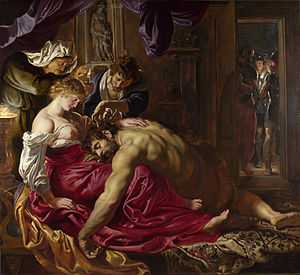Samson and Delilah (Rubens)
 | |
| Artist | Peter Paul Rubens |
|---|---|
| Year | 1609–1610 |
| Type | Oil on wood |
| Dimensions | 185 cm × 205 cm (73 in × 81 in) |
| Location | National Gallery (London) |
Samson and Delilah is a painting by the Flemish Baroque painter Peter Paul Rubens (1577–1640). It dates from about 1609 to 1610.
Narrative
The painting depicts an episode from the Old Testament story of Samson and Delilah (Judges 16). Samson, having fallen in love with Delilah, tells her the secret of his great strength: his uncut hair. Rubens portrays the moment, when having fallen asleep on Delilah's lap, a servant proceeds to cut Samson's hair. After, a weakened Samson is arrested by Philistine soldiers. The soldiers can be seen in the right-hand background of the painting.
Symbolism
The niche behind Delilah contains a statue of the Venus, the Goddess of love and her son, Cupid. This can be taken to represent the cause of Samson's fate.
The old woman standing behind her, providing further light for the scene, does not appear in the biblical narrative of Samson and Delilah. She is believed to be a procuress, and the adjacent profiles of her and Delilah may symbolise the old woman's past, and Delilah's future.
The Philistine cutting Samson's hair has his hands crossed as he cuts, this is a sign of deceit.
Provenance
The painting was commissioned by Nicolaas Rockox, alderman of Antwerp, Belgium, for his town house.
The painting was sold when Rockox died in 1640, eventually forming part of the Liechtenstein Collection in Vienna, Austria, in the eighteenth century, along with another Rubens masterpiece, Massacre of the Innocents.
The picture sold at auction in 1980 at Christies, purchased by the National Gallery, London for $5 million.
There has been some doubt cast over the attribution of the painting to Rubens, led by the artist and scholar of Fayum portraits Euphronsyne Doxiades. She argues that it varies in details from copies of the original made during Rubens' lifetime, that it does not employ the layering technique of glazing common in oil painting at the time and mastered by Rubens, and that its provenance can not be documented with certainty between 1641 and 1929. A dendrochronological examination of the painting, however, confirms that the painting dates to the correct period, and the attribution has been accepted by a majority of the art historical scholarly community.
The painting was earlier attributed to the Dutch painter Gerard van Honthorst, a painter who, like Rubens, worked in Rome in the shadow of Caravaggio at the start of the 17th century.
References
- Samson and Delilah at the National Gallery, London
- Samson and Delilah at the Web Gallery of Art
- Article about the controversy at Salon.com
- AfterRubens.com, the Site of Euphronsyne Doxiades
- A self-published Geocities page about the painting
| ||||||||||||||||||||||||||

